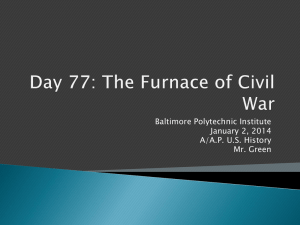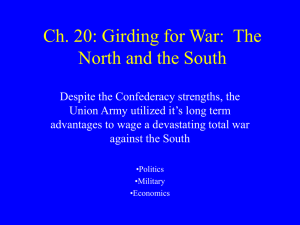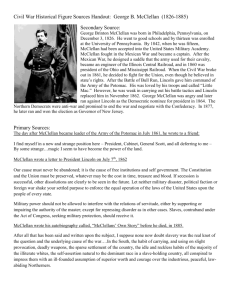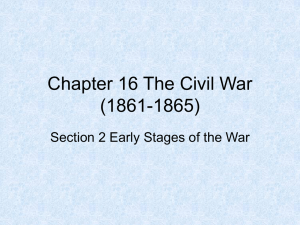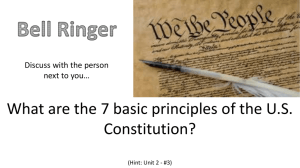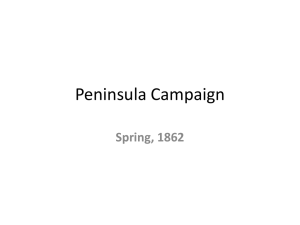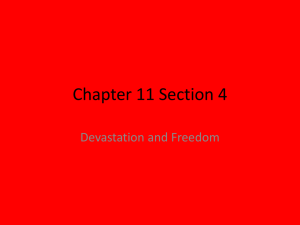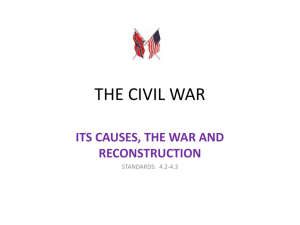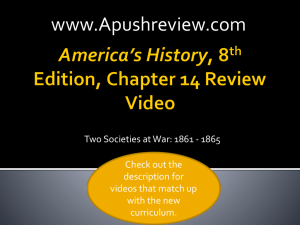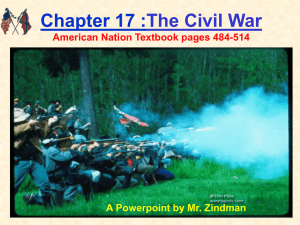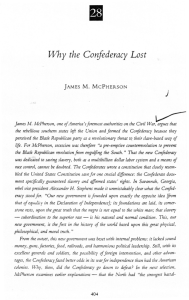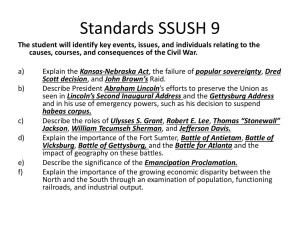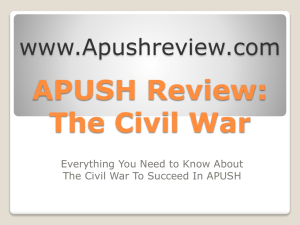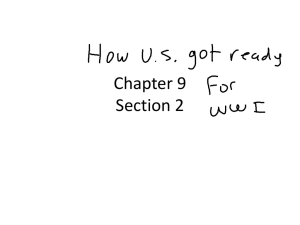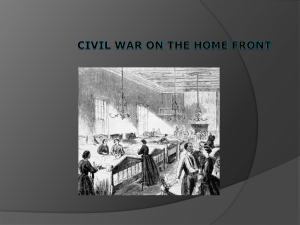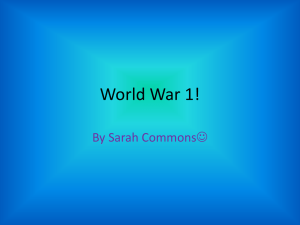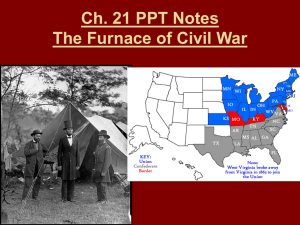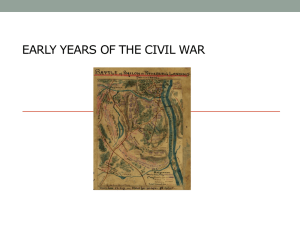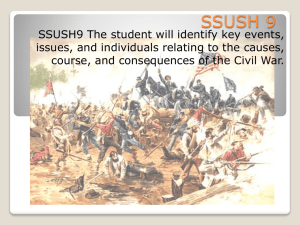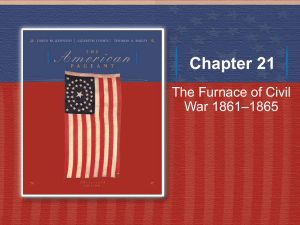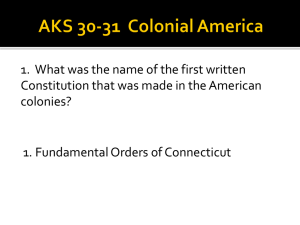Junior High American History Chapter 16 - Meile
advertisement
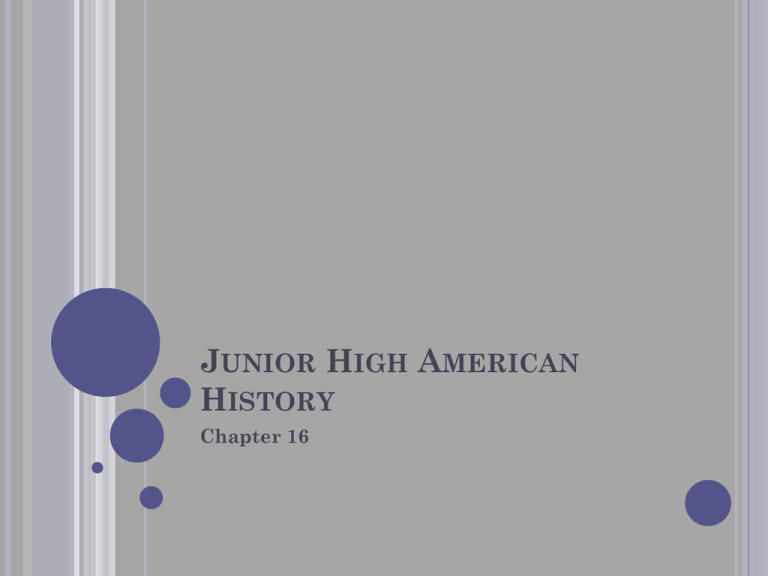
JUNIOR HIGH AMERICAN HISTORY Chapter 16 CHAPTER 16 SECTION 1 1. Geography Which slave states stayed in the Union when the Confederacy was formed? Missouri, Kentucky, Delaware, and Maryland 2. Geography For each state, give the strategic advantage(s) its location offered. Missouri Kentucky Controlled the Ohio River Delaware could control parts of the Mississippi River and major routes to the West Was close to Philadelphia Maryland close to Richmond, vital railroad lines passed through it; Washington, D.C., lay within it 3. What area seceded from the South and joined the Union? West Virginia 4. What advantages did the North have over the South? larger population more industry, more resources better banking system better navy better railway network Lincoln 5. Why would invading and holding the South be difficult for the North? It was a large area filled with a hostile population 6. What advantages did the South have over the North? strong support of its white population fighting in familiar territory superior militaryleadership 7. How did a strong belief in states’ rights hamper the South’s efforts? Individual states refused to give the Confederacy Government enough power to fight effectively 8. What was the main goal of the North at the outset? To bring southern states back into the Union 9. What main strategies were included in the Union’s plan for winning the war? blockade Southern ports Gain control of the Mississippi River capture Richmond 10. What were the main goals of the South? win recognition as an independent nation preserve the Southern way of life which included slavery 11. Why did the South expect Great Britain and France to pressure the North to end the war? So their cotton supply would be restored 12. How could most Civil War soldiers be described? Young and inexpierenced CHAPTER 16 SECTION 2 1. Where was the first major battle of the Civil War? Bull Run 2. Eyewitness to History Who were the two generals who led the South in this battle? P.G.T. Beauregard Thomas (Stonewall) Jackson 3. Who won this battle? South 4. What was the Union army of the East called? The Army of the Potomac 5. Who headed the Union army of the East? General George B. McClellan 6. Why did Abraham Lincoln order a blockade of Southern ports? to prevent the South from exporting cotton or importing war supplies 7. How did the South challenge the blockade? blockade runners they covered the Merrimack in iron plates and attacked Union warships. 8. What was the North’s first strategic goal in the West? To gain control of the Mississippi and Tennessee Rivers 9. Geography How long did the Battle of Shiloh last? 2 days 10. Geography Who was victorious in the Battle of Shiloh? The North 11. Why was David Farragut’s capture of New Orleans significant? It meant that the Confederacy could no longer use the Mississippi River to carry its crops to sea. 12. What was George McClellan’s goal in March of 1862? To capture Richmond 13. What was McClellan’s operation known as? The Peninsula Campaign 14. How did McClellan’s delays benefit the Confederates? They had time to prepare their defense at Richmond 15. Who commanded the South’s army for the Seven Days battles? General Robert E. Lee 16. What was the outcome of McClellan’s offensive? He failed to capture Richmond 17. What took place on August 29, 1862? The Second Battle of Bull Run 18. Who was victorious? The South 19. What advantage over the South did the North have when it launched an offensive into Maryland in September 1862? They had a copy of Lee’s orders 20. When was the single bloodiest day of the war? Antietam ~ September 17, 1862 21. How did Lincoln react to McClellan’s repeated hesitance? He removed him from command and replaced him with General Ambrose Burnside. CHAPTER 16 SECTION 3 I. Emancipation A. Why did Abraham Lincoln hesitate to move against slavery? making an issue of slavery would divide the people and make the war less popular B. How did Northerners’ attitudes toward slavery change as the war went on? They believed that slavery was helping the war effort in the south C. Citizenship Why did Lincoln wait to issue the Emancipation Proclamation? He did not want to appear to be acting in desperation when the North seemed to be losing the war. D. Citizenship Why did the proclamation not actually free any slaves? It applied only to the areas the Confederacy controlled E. Citizenship What effect did Lincoln hope the proclamation would have on many slaves? It would encourage them to runaway from their owners F. Citizenship What effect did the proclamation have in Europe? Great Britain and France decided to withhold recognition of the Confederacy. G. Citizenship Which amendment, ratified in 1865, truly freed the slaves? 13th II. AFRICAN AMERICANS HELP A. When the Civil War began, what percentage of the Confederacy’s population was made up of slaves? 40 % B. By the end of the war, what portion of the Confederacy’s enslaved population had fled to Union areas? About ¼ C. What was the main reason Southerners did not want to use African Americans as soldiers? Feared that they would revolt D. Before they were allowed to serve as soldiers in the Union army, how did African Americans aid the Union war effort? Guides and spies E. What was the 54th Massachusetts? An African American regiment F. How did the events of July 18, 1863, win respect for African American troops? Nearly half of the soldiers in the 54th Massachusetts were wounded, captured, or killed in a brave attack on a Confederate fort G. What logic, first expressed by General Ulysses S. Grant, did Lincoln use to refute the criticism of his use of African American soldiers? They would make good soldiers, and using them would weaken the South while strengthening the North. CHAPTER 16 SECTION 4 1. Where did most soldiers live during the Civil War? In camps 2. Why were the new rifles preferable to muskets? They were more accurate 3. What kind of warfare was used by both sides? Trench warfare 4. Why did many soldiers desert the armies? fear, hunger, or sickness (worries about their families) 5. What was one of the reasons General Robert E. Lee invaded Maryland in 1862? To allow his hungry army a chance to feed off the crops 6. What new responsibilities did women take on during the war? They became teachers Office workers sales clerks Government workers. They worked in factories and managed farms. 7. How did women help the armies? They rolled bandages, wove blankets made ammunition collected supplies raised Money served as spies and nurses 8. Who were Rose O’Neal Greenhow and Belle Floyd? Confederate spies 9. Why did many men disapprove of women serving as nurses? Believed they were to delicate, and didn’t want them working on unknown men's bodies 10. Who were the Peace Democrats? Northerners who opposed the president and favored negotiating with the Confederacy 11. When did the Confederate Congress pass a draft law? April 1862 12. How could a man avoid the draft in the South? By hiring a substitute or by owning 20 or more slaves 13. When did the North pass a draft law? March 1863 14. How could a man avoid the draft in the North? by hiring a substitute paying the government $300 15. Why did angry mobs riot in New York City in July 1863? To oppose the draft and fight to free Americans 16. What three methods did both sides use to raise money for the war? borrowing money increasing taxes printing paper money 17. When did the United States Congress first pass an income tax? 1861 18. How did the war affect the economy in the North? The economy boomed 19. How did the location of the war’s battles affect the economy in the South? The war was fought mainly in the South, so much of the South was ruined. 20. What effect did economic conditions have on Confederate soldiers? Many deserted because of worries about their families CHAPTER 16 SECTION 5 1. On December 13, 1862, at the Battle of Fredericksburg, Union General Ambrose Burnside clashed with General Robert E. Lee. The Confederates were victorious. 2. In May 1863 the Confederates won at Chancellorsville. 3. In July 1863 the three-day Battle of Gettysburg ended in a victory for Union forces led by General George Meade. 4. Eyewitness to History The last attack in this battle was Pickett’s Charge. 5. At the same time, a battle took place at Vicksburg, Mississippi. 6. On November 19, 1863, Abraham Lincoln delivered a two-minute speech called the Gettysburg Address. 7. Biography Ulysses S. Grant’s victories impressed Lincoln, who named Grant commander of all Union armies. 8. According to Grant’s plan the Army of the Potomac would crush Robert E. Lee’s army in Virginia; the western army would advance to Atlanta, Georgia. 9. In May and June of 1864 Grant’s and Lee’s armies fought three battles near Richmond. Then Grant attacked Petersburg. 10. William Tecumseh Sherman led his troops on an historic “march to the sea” to Savannah, Georgia. 11. On April 2nd 1865, Grant defeated the Confederates at Petersburg. 12. Lee surrendered to Grant on April 9, 1865;in a village called Appomattox Court House. 13. More than 600,000 soldiers died in the war. 14. The war caused bitter feelings among defeated Southerners that lasted for generations. 15. The war freed millions of slaves.
